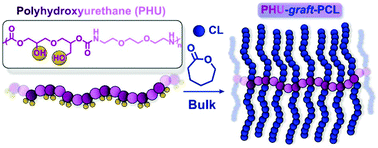Solubility-governed architectural design of polyhydroxyurethane-graft-poly(ε-caprolactone) copolymers†
Abstract
Polyhydroxyurethanes (PHUs) are strong candidates for replacing conventional isocyanate-based polyurethanes (PUs), yet analogous structural diversity and subsequent properties have so far not been reached for PHUs. Here, we demonstrate that by rational design of the PHU microstructure and utilization of solubility as an enabling tool, complex architectures can be realized with benign reagents and atom-economical reactions, without harsh reaction conditions and solvents. Polyhydroxyurethane-graft-poly(ε-caprolactone), PHU-graft-PCL, copolymers were synthesized through graft ring-opening polymerization of ε-caprolactone (CL) from the pendent –OH groups of a PHU. The structure of the PHU was carefully designed to allow its dissolution in CL and enable bulk polymerization conditions. Solubility tests of different PHUs in various lactones corroborated that the PHU-lactone structure pair was critical to achieve dissolution. The optimum reaction conditions were kinetically determined, the copolymers’ structure was confirmed by 1H, DOSY and 31P NMR spectroscopy and their thermal properties were evaluated by DSC and TGA analysis. Our work demonstrated the effectiveness of utilizing solubility to achieve complex architectures, expanding the synthetic intricacy for PHUs and could expand their future applications and opportunities.



 Please wait while we load your content...
Please wait while we load your content...